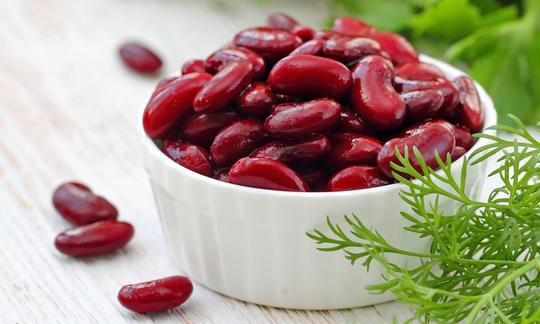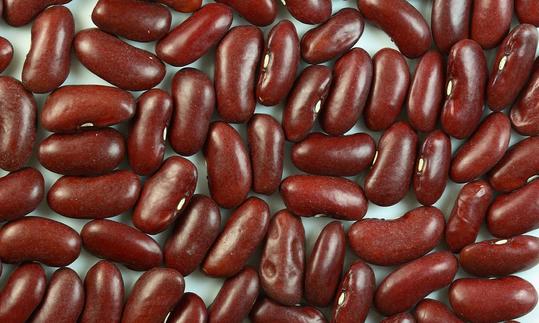Table of contents
Kidney beans are the large, red seeds of the common bean ( Phaseolus vulgaris ). When cooked, they are a great source of fiber and protein, preferably without salt.
Use in the kitchen
Kidney beans get their name from their typical kidney shape. The shell is red-brown, the inside is white-cream colored. They are closely related to white beans . Due to their sweet, nutty taste and tender texture, they are particularly popular with children.
Well-known dishes with cooked kidney beans are "chili con carne", for which there are many delicious, meat-free alternatives called chili sin carne, see recipe below. They are also used in salads, for example in quinoa salad with avocado and bell pepper . Kidney beans combine well with corn kernels , red bell peppers and cucumber in an oil-free salad dressing with avocado and onion .
The beans can be bought dried and packaged or in canned form. The latter are already cooked and allow for quicker preparation. They should be rinsed well before use in order to dilute any preservative liquids as much as possible. We recommend preparing them with dried beans, even if this takes more time (see our own preparation further down in the text). Raw kidney beans are poisonous due to the lectin they contain. They must therefore always be soaked and then cooked or sprouted before eating them.
Your own preparation
Soak the dried kidney beans overnight in three times the amount of water, or for 8-12 hours. This reduces the phytic acid in the beans. Phytic acid binds minerals in the human body, so that they are no longer available to the organism. More on this here: " Phytic acid or phytate and soaking or sprouting ".
Pour away the soaking water and rinse the beans well. Put the beans in a pot and fill them with water until they are generously covered. Simmer on a medium heat for 45 to 60 minutes until they are as firm as you want. You can cook beans in a pressure cooker without soaking in 30-40 minutes. To make the beans cook faster, you can add a teaspoon of baking soda to the soaking or cooking water. The baking soda softens the calcareous water and the beans cook faster. You will also sometimes find information that this makes the beans more digestible and causes less flatulence. Acids such as tomato sauce, vinegar and lemon juice should only be added at the very end. Contrary to previous assumptions, salt shortens the cooking time because it softens the cell walls of the beans (and other legumes such as lentils and chickpeas). 4
Vegan recipe for chili sin carne with red beans
Ingredients (for 4 people): 2-3 cloves of garlic , 2 onions , 2 carrots , 120 g soy granules , 400 ml low-salt vegetable stock , 2 tbsp rapeseed oil , 1 red chili pepper , 1 tsp hot paprika powder , 50 g tomato paste , 500 g chopped tomatoes , 250 g cooked kidney beans, 300 g corn kernels , salt ,black pepper .
Preparation: Peel and finely chop the garlic. Peel and dice the onions and carrots. Halve the chili peppers and remove the seeds if necessary. Cut into fine strips. Put the soy granules in a bowl, pour the vegetable stock over them and soak for 5 minutes. Then drain in a sieve and squeeze out, collecting the liquid. Heat the oil in a pan. Add the onions, carrots and soy granules and fry for approx. 5 minutes, stirring frequently. Then add the garlic, chili, paprika powder and tomato paste and fry briefly. Wash and dice the tomatoes. Add the tomatoes, collected vegetable stock, kidney beans and corn kernels. Season with salt and pepper. Simmer for approx. 20-25 minutes over a low heat. Then season to taste if necessary. The chili sin carne goes well with cooked wholegrain rice .
Vegan recipes with cooked kidney beans can be found under the note: " Recipes that have the most of this ingredient ".
| Not only vegans or vegetarians should read this: Vegans often eat unhealthily. Avoidable nutritional mistakes . |
Purchasing - Storage
Kidney beans can be bought dried or already cooked in jars or cans, sometimes even in organic quality. They are available all year round . They are usually available in the large supermarket chains such as Coop , Migros , Spar , Rewe , Edeka , Hofer , Aldi , Denner , Volg , Lidl and Billa . Kidney beans are also available in organic supermarkets such as Denn's Biomarkt or Alnatura or in health food stores.
The availability of kidney beans in the supermarkets mentioned varies depending on the size of the store, catchment area, etc. If you are interested, click on our recorded food prices for the DA-CH countries (above under the ingredient image). There you will find current prices from various supermarkets and their price development.
Storage tips
Cooked kidney beans can be stored in an airtight container in the refrigerator for one to two days. 3
Ingredients - Nutritional values - Calories
Cooked kidney beans (organic) contain 127 kcal per 100 g. They are very rich in fiber with 25.0 g/100g. 100 g of beans contain 6.4 g of protein and 23 g of carbohydrates. The fat content is low at 0.50 g/100g. 1
Kidney beans are rich in folate (folic acid) with 130 µg/100g. This corresponds to 65% of the daily requirement.Cooked black beans have 149 µg and cooked lentils around 181 µg per 100g. 1
The protein-rich beans contain all eight essential amino acids. However, only tryptophan and threonine are contained in larger quantities, at 0.10 g and 0.32 g per 100 g respectively. This corresponds to 42.0% and 34% of the daily requirement. 1
The trace element manganese is contained at 0.43 mg/100g. Cooked white beans (0.52 mg) andcooked black beans (0.44 mg) have a similar content per 100g. Cooked chickpeas, for example, have significantly higher values at 0.99 mg/100g. This corresponds to 49% of the daily requirement. 1
The complete ingredients of cooked kidney beans, the coverage of the daily requirement and comparison values with other ingredients can be found in our nutrient tables. In the article Nutrients explained you will get a detailed insight into the topic.
Effects on health
Cooked kidney beans contain plenty of folic acid. This is involved in important metabolic reactions (DNA and RNA synthesis). Too little can cause genetic damage. Folic acid is also important for the development of the central nervous system. Folic acid is particularly important for women who want to have children. The German Nutrition Society recommends that women increase their folic acid intake before pregnancy (requirement 600 µg) to prevent birth defects in the newborn. 12 Eating foods containing folic acid, such as beans, reduces the risk of pancreatic and colon cancer. 13 However, too many artificial folic acid preparations can increase the risk of developing cancer. 14
Dangers - Intolerances - Side effects
Like all varieties of common beans, kidney beans are harmful when eaten raw, as they contain several substances that are incompatible with humans, including the lectin phasin (phytohemagglutinin), phytic acid and protease inhibitors. These can be reduced by soaking in water for several hours and then cooking or sprouting, so that the beans can be eaten.
Eating kidney beans can lead to increased gas formation in the large intestine and thus to bloating and flatulence. This is due to the polysaccharides (oligosaccharides) contained in the beans, which ferment the intestinal bacteria and thereby secrete gases. 15 You can find out how to reduce this under the ingredient kidney beans, ripe seeds, raw .
Ecological footprint - animal welfare
Pulses such as beans, chickpeas , soybeans , lentils and peas are considered a healthy plant-based source of protein due to their high protein content and fiber. They have a better environmental impact than milk and meat products. Their ecological footprint is smaller because they require less arable land and water and have fewer CO2 emissions. It is therefore more environmentally and climate-friendly to eat plant-based proteins and corresponding meat substitutes than meat and milk products. In addition, many calories are lost during meat and milk production because more plant-based calories have to be fed to the animals than are ultimately produced as animal calories. 9,10,11 You can find more information about this under Basic knowledge .
Cooked, edible kidney beans can be bought in shops either in jars or cans. The latter are usually made of aluminum or tinplate. The production of aluminum requires a lot of energy and the raw material bauxite, which has to be mined on large areas (including rainforests). In addition, aluminum production produces an intermediate product that is toxic to the environment, so-called red mud (contains iron and titanium oxides). If disposed of improperly, this can cause serious environmental problems. 16 Aluminum can be recycled after use, but this process is also energy-intensive. 17 However, the same applies to the production and recycling of glass. The weight during transport also has a negative impact. 18 Ideally, you should buy kidney beans raw and prepare them yourself, which reduces the amount of carbon emissions than if you buy kidney beans already cooked. Compared to other pulses such as lentils or chickpeas, however, kidney beans perform slightly worse in this regard. 19
Worldwide occurrence - cultivation
Kidney beans are a type of common bean (Phaseolus vulgaris). They originally come from Central America and the Andean region of South America. Until now, it was assumed that there were two cultivation centers, but more recent studies show that the common bean was probably first domesticated in Mexico and only later planted in the Andean regions. 5 Common beans were introduced to Europe in the 16th century. Since varieties from Central and South America were planted, Europe's own varieties developed over the centuries through hybridization. 6
In international trade, no distinction is made between the individual varieties of garden beans. According to FAOSTAT, 27.4 million tons of dried beans were produced worldwide in 2020. 2
For information on cultivation and harvesting, see the article Kidney beans, mature seeds, raw .
Industrial production
Kidney beans can be bought in cans or jars. The beans are usually sent to the processing plants as dry products. First they are soaked in water overnight. Then they are briefly blanched at 80 to 85 °C. After filling the cans, they are filled with infusion liquid. This often contains salt and spices, sometimes also modified starch. The latter prevents the kidney beans from bursting during sterilization. After the cans are hermetically sealed, they are heated in special pressure vessels at overpressure to 115 to 140 °C. They are then quickly cooled to 20 °C so that the beans do not overcook and become mushy. 7
Italy is the world's largest producer and supplier of canned beans. 8
Further information
Kidney beans are a variant of the common bean ( Phaseolus vulgaris ). This belongs to the subfamily Faboideae. The pods of the common bean ( Phaseolus vulgaris ) can be flat or round in cross-section, and can be marbled in different colors such as green, yellow, purple or black. The seeds of the common bean also have different colors and shapes. The red, slightly kidney-shaped beans are called kidney beans.
Alternative names
Kidney beans are also called Indian beans or red beans. They are also spelled kidney beans. Red kidney beans should not be confused with the adzuki bean ( Vigna angularis ) and the runner bean ( Phaseolus coccineus ).











Comments